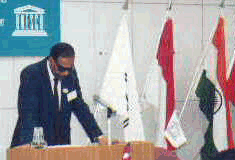
Education in an Information Age
- as seen in Japan

It was a wet day. Rupert Maclean, who is the head of the APEID in Bangkok, expressed concern over the glaring gulf between the haves and havenots in the developing countries of Asia. He holds views close to my line of thinking that for re-engineering change in school systems in countries like Bangladesh and India, use of advanced information and communication technologies such as distance education using satellite, electronic resources like the Internet and CD-ROM would be crucial. They offer the possibility of providing access to students studying in schools deficient in learning resources global educational resources abundantly available in the cyberspace. Yamashita who is the Dean of International Programmes of the Hiroshima University mentioned the recent economic crisis faced by Thailand with repercussions on Malaysia and Singapore. According to him the root cause of the problem in these countries was that they had boosted their economy depending on low-paid labour and free foreign investment. When other countries of Asia such as India got on to the game of competing not on the strength of quality of their products but also using cheap labour it has resulted in economic hiccups that Thailand is going through.
My web pages were downloaded from the Internet. I made my presentation using the intense mercury light overhead projector. My slides appeared sharp and clear on the screen.

I presented as case studies the CLASS Project (Computer Literacy and Studies in Schools), the Indian experiment for introducing computers in schools, teacher training using teleconferencing and, of course, showed my Homepage. Seeing that my country paper could be accessed from the Internet stunned most of the participants who had come from 9 developing countries of Asia and the Pacific Region. There was general curiosity to know the amount that is to be paid in India for obtaining an annual Internet account and the scope of its availability . The Rs l5,500 charged by the VSNL for 500 hours of Internet use is about US $ 500. An impact of my presentation was that it enabled the others to appreciate that through Internet not only custom-made resource materials can be put on the world wide web to support the school system but by surfing the cyberspace users can reach resources now globally available as freeware. I found out to my happiness that in the library of the Hiroshima International Plaza hot-Internet connections were available for residents' use. I sent e-mails to Asha (India), Miyazawa (Japan), Gargi and Niranjan (USA). I did not step out as it rained through out the day.